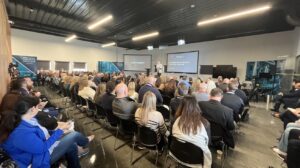At any given work site, categories of Health, Safety, and Environment (HSE) challenges facing workers are generally consistent, even if the particulars may vary. HSE officers know what they are up against from day to day—for example, the human factor, machine and worker proximity, insufficient real-time monitoring, etc.—but HSE improvement is very difficult to enact amid dynamic risk factors in a fast-paced operational environment. Incidents such as ergonomic-related injuries, “slips, trips, and falls,” collisions with vehicles, and PPE compliance violations continue to occur at high rates and with serious consequences despite common approaches to improve safety technology, training, and process refinements.
In a recent webinar hosted by EHS Today entitled “From Good to Great: How Visual AI Turns You Into a Safety Superstar,” our Vice President of Visual AI Advisor, Jodie Sasse, and Head of Product for Visual AI Advisor, Jaidev Amrite, detailed the critical drivers of HSE costs and how artificial intelligence can automatically detect real-time unsafe acts, near misses, and even help HSE officers intervene before expensive safety accidents arise.
Every dollar spent on HSE improvement yields a twofold return on investment
Sasse began by citing a study by LNS Research that showed how insufficient cross-functional collaboration, disparate systems that don’t talk to each other, and undefined and unstandardized business processes are among the top factors preventing companies from meeting their business objectives. These factors make it difficult to control the HSE environment. She noted how the human element plays a significant role in workplace incidents. Workers can get tired and distracted and may bring personal issues to work that takes their mind off the safety element: and it only takes a moment for disaster to strike. Human memory is biased and demonstrably forgetful. Consciously or unconsciously, humans can neglect to follow safety protocols. Sometimes, they assume accidents won’t happen to them or presume that their coworker is paying as close attention to safety as they would. Furthermore, a worker’s expertise level and ability to apply training effectively within their day-to-day work environment are also significant factors.
Amrite pointed out that even with substantial investments in training and preventive measures, the complex operations of work sites make it challenging to prevent incidents. For example, forklifts in warehouses and manufacturing facilities are constantly hauling heavy loads, with workers passing nearby. Shutting down an entire aisle due to the presence of a forklift is simply not practical, yet there were almost 7,500 accidents related to forklifts in 2020, with a median cost of $115,000. Real-time monitoring is also a challenge for many companies. Although investments have been made to deploy additional sensors, IoT, and data generation, without the ability to use data insights to be proactive and take real-time action, how much does that data help throughout a workday? Can they capture the moments before an incident occurs to study the root cause? Can they effectively quantify the impact of new controls, training, and procedures on incident reduction efforts?
Amrite and Sasse explained that, on average, organizations spend around $40,000 per safety incident, which can balloon up to $1.2 million if there is a fatality. There are indirect costs related to workplace accidents, such as productivity loss, shutdowns, and brand image damage, too. Given the high cost of incidents, HSE investment is a top priority for organizations. CFOs that SparkCognition has interviewed say that every dollar spent on HSE improvement yields a twofold return on investment. The question is: what solution provides the best balance of total visibility, actionable insights, non-disruptive deployment, and scalability across the enterprise?
Visual AI Advisor: A transformative solution for HSE improvement
Pivoting to the answer, the two began to walk through the many layers of SparkCognition Visual AI Advisor that combine to create a transformative solution for HSE improvement. Visual AI Advisor uses artificial intelligence and computer vision to identify safety hazards and prevent incidents before they occur by analyzing real-time video footage and alerting workers to any potential safety hazards, leveraging common CCTV camera infrastructure warehouses and manufacturing facilities likely already have in place.
Using proven computer vision technology that deploys in days, Visual AI Advisor can detect safety hazards such as workers not wearing PPE, slip and trip hazards, and unsafe behaviors like following proper lifting techniques. It can also monitor heavy equipment like forklifts and trucks to identify potential safety hazards in real time.

The following exchange, in which Amrite and Sasse review a real-world video capture of Visual AI Advisor tracking a forklift traveling down a busy warehouse corridor, provides a window into the insights you’ll find in this webinar, available now in our on-demand library:
Amrite: We talked a little bit about forklifts before, and I wanted to bring this example because, personally, I love this. All of us are familiar with going into hardware stores where, you know, if they have a forklift in a particular aisle, they just close the aisle off, right?
Nobody’s really going into that aisle. Now, of course, if you’re operating a warehouse or a production floor, that’s not really a choice. And guess what? Forklifts, hand-operated trucks, and battery-operated trucks are so commonplace in most industrial environments that people often just get complacent in terms of how they behave around these things.
And, of course, this is the type of attitude that sometimes leads to, you know, really terrible things happening right now. How do we make sure that we can still let machines and humans coexist but still maintain a good safety posture?
So this is actually a good example where what you see at the scene is: the AI is actually watching as the forklift is moving down these aisles, and you’ll notice at the beginning of this clip when the forklift is just moving down the straight path—which is generally predictable—the AI doesn’t necessarily raise the level of alert on that activity. It doesn’t perceive that to be a highly risky activity.
But when the forklift starts to do something high risk, like make a turn, for example, or when it starts to occupy more area, or it starts to get close to a human or to other goods that are stacked in the scene, you see that with the redness [bounding box] that is being depicted in this video. You see that the AI starts to monitor it with higher vigilance. The AI is taking appropriate action based on how the scene is evolving. And now, once, let’s say, the AI decides that, “Oh, this is a hazardous situation or a risky situation,” it can not only record this incident as an example of a near miss, but it can also proactively send an alert, let’s say, to personal devices that some of these people might be wearing in the scene.
Let’s say that you had some of these workers that were wearing noise protection equipment, and so they couldn’t hear the forklift actually come in. Then flashing lights or a light skirt can be projected out of the forklift so that people in the vicinity can be made aware in the right ways that there is imminent risk or danger in this particular area.
So the advantage of AI is not just that we get the ability to spot these things that perhaps we were missing before, but you can also intervene and prevent things from happening before something really terrible happens.
Sasse: I have two points to make. One is on the unsafe acts, in the beginning, that capture those things before an incident actually occurs. You know, you hear about Heinrich’s triangle theory. It all starts with those unsafe acts that ultimately become incidents as well as fatalities. The other thing that’s interesting, as I look at this example: I know this client very well, and they have a no-blame environment.
So folks sometimes ask, “Well, how are they using it then?” Well, if you can better train your employees. You can actually prevent these things from happening. It’s not always about: “I’m gonna get somebody in trouble.” It’s more about: “How do I keep my employees safe so that they do go home to their families at the end of the day?” And my risk profile for my organization is as low as possible.
Amrite: I will say this from personal experience, you know, oftentimes employees in these types of situations have been extremely excited when they were given personal devices such as smartwatches or alert bands that would alert them to the presence of imminent danger because they saw that their employers were taking an active interest in their safety. So sometimes these systems are welcomed in these types of environments. The other thing I’ll say is you made a very non-trivial point about reporting and capturing these unsafe acts and near misses. You know, safety pyramids, safety triangles, these are processes or analysis of near misses are, are processes that, that, that EHS professionals are required to do by law to show that they’re maintaining, you know, good controls in their environments.
And oftentimes, because these things are so underreported, near misses specifically, it’s often a large burden at the end of a reporting period to frantically collect all this data. Guess what? [Visual AI Advisor] is now automatically collecting all of this for you, perhaps even organizing it into classifications so that you can just basically review those reports as opposed to spending your precious time collecting data out in the field.
Sasse: And I love those reports, not only from looking at an individual site, but many sites have the same types of operations and the same equipment. Being able to leverage that data to say, “What is site A doing versus site B, and why are they different? You know, what’s different that is causing one to outperform another?” This is a really interesting insight that clients are able to capture.
Amrite: “And people love that gamification aspect, right? It’s a virtuous cycle—you can actually maintain a better safety posture, reduce incidents, and be rewarded for being safe in a traceable, auditable, reportable way.
The bottom line: HSE is about preventing incidents before they occur
Amrite and Sasse’s highly-informative presentation breaks down how HSE supervisors can use real-time alerts and take action to prevent incidents before they occur. Visual AI Advisor also provides data and insights that organizations can use to make data-driven decisions and improve safety performance.
Safety should always be a top priority in any work environment. Visual AI Advisor delivers an innovative approach that can help organizations turn their workers into safety superstars, taking advantage of real-time data and insights to improve safety performance and prevent incidents before they occur.
To learn more, watch the entire webinar here:
From Good to Great: How Visual AI Turns You Into a Safety Superstar
















